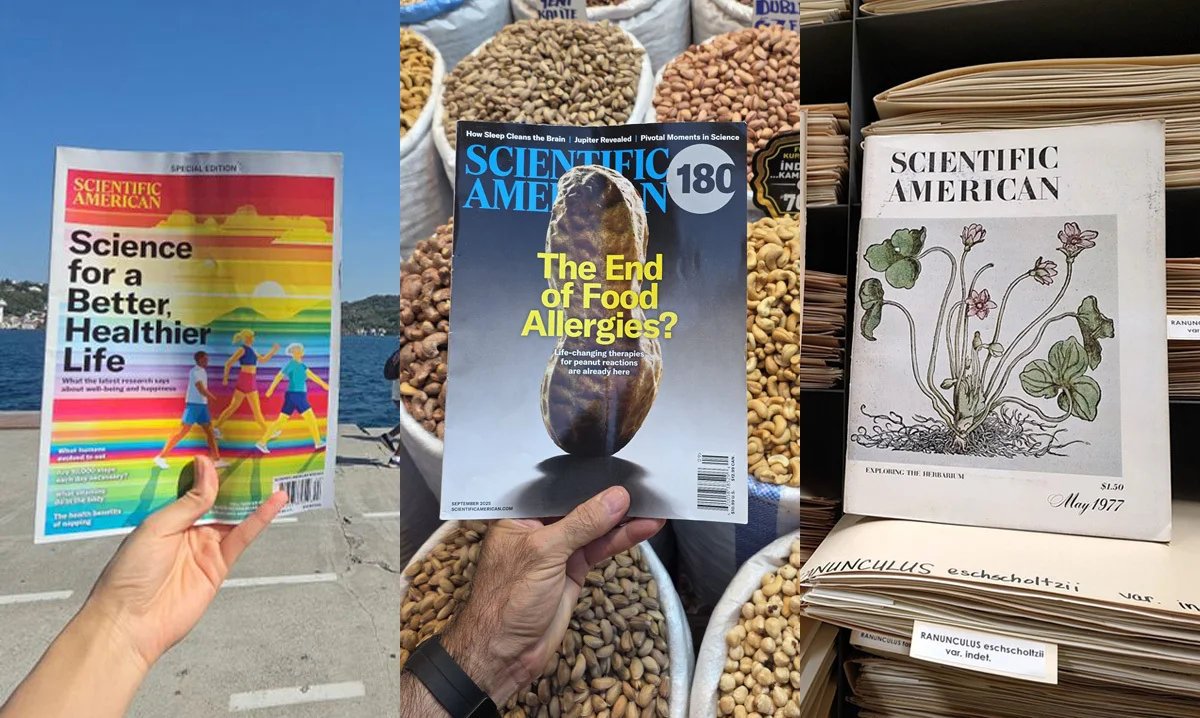
Scientific American celebrated its 180th birthday on August 28, 2025, by highlighting the many ways science has evolved over nearly two centuries.
Since Scientific American’s inception 180 years ago, its covers have taken readers on epic journeys—from deep oceans to distant galaxies. Decade by decade, the magazine’s covers have showcased incredible artistic renderings of breakthrough science and debuted 27 different logos. To honor the long-standing legacy of the brand and our vast archive of covers, we invited readers to take part in a visual storytelling challenge called #SciAmInTheWild.
The task for our readers was to take an original, high-quality photograph of the cover of any physical issue of Scientific American magazine in an interesting, beautiful or unexpected setting where science met scenery that reflected or complemented the theme of the cover. Settings could include but were not limited to natural landscapes, cityscapes, laboratories or museums. Those who took part in the contest e-mailed us or posted their photographs on Instagram, Bluesky, LinkedIn or TikTok. The concept of this challenge was born while we were poking around our archive. As the longest continuously published magazine in the U.S., our history quite literally predates everybody on our staff and even the discovery of Neptune.
On supporting science journalism
If you’re enjoying this article, consider supporting our award-winning journalism by subscribing. By purchasing a subscription you are helping to ensure the future of impactful stories about the discoveries and ideas shaping our world today.
The submissions exceeded our wildest expectations! Have a look at some staff favorites below. Although the contest has officially ended, our curiosity and the spirit of exploration don’t end here. We continue to challenge you to get out in the world and bring #SciAmInTheWild!
Saransh S.
Istanbul, Türkiye
September 2025
“Amid the colorful chaos of the Egyptian Bazaar, where centuries of trade, spices, and stories converge. Surrounded by mountains of peanuts, pistachios, hazelnuts, and cashews, I placed my copy of Scientific American [which has a cover that reads] ‘The End of Food Allergies?’ It felt symbolic—here in a place where food is history, culture, and livelihood, science is offering hope that everyone may one day share fully in these flavors without fear.”
Walter F.
Pullman, Wash.
May 1977
“The May 1977 issue of Scientific American had a cover story on herbaria and featured an engraving of hepatica. This issue is posed next to a hepatica specimen at the Marion Ownbey Herbarium at Washington State University.”
Ilgın A.
Istanbul, Türkiye
December 2024 Special Edition
“While visiting my home country, Türkiye, I brought this issue from last year for SciAm’s 180th anniv contest. I thought it was a perfect match for the cover, with people who usually run here and the Bosphorus Bridge in the background, which connects Asia and Europe.”
Ben G.
Bridgton, Me.
June 2025 Special Edition
“It’s hard to book a trip to the quantum realm, but I’ve enjoyed reading about it during my vacation in Bridgton, Maine! Coincidentally, Bridgton is home to @rufusportermuseum [the Rufus Porter Museum Of Art And Ingenuity], whose exhibits highlight the artistic & technical achievements of @scientific_american [and] @sciam.bsky.social’s founding editor!”
Ralph L.
Portland, Ore.
September 1977
“I worked for Intel from 1978 until 2005. The September 1977 issue inspired me to look for a job in that field when I graduated with a degree in chemistry. Searching around Portland, Oregon, I thought this exhibit at the Oregon Museum of Science and Industry (OMSI) fit the ‘out in the wild’ theme but represented the technology. Thanks for many years of the magazine. Martin Gardner’s Mathematical Games columns were always my favorite that I opened the magazine to when new issues arrived. Keep up the great podcasts now. One of my favorites.”
Jennifer M.
Englewood, Colo.
December 2024
“I had to use our library’s hard copy of your magazine, since I always read them online and through Libby. I don’t think it ruins the shot. Thanks!!”
David D.
Escondido, Calif.
February 1970
“Here is a photo of the February 1970 SciAm displaying a portion of an integrated circuit with over 800 transistors. I placed a Raspberry Pi computer on top for comparison. This version has billions of internal transistors. This just shows how far forward SciAm is always thinking!”
Adrian J.
Boulder, Colo.
April 2025
“The location of the photo is at NIST [the National Institute of Standards and Technology] in Boulder, Colorado. The photo shows a Penning trap, which is a quantum simulation and sensing experiment. In the photo is a portion of an optics table and a superconducting magnet that traps Beryllium ions. The April 2025 [article ‘The Hidden World,’ the subject of this cover] discusses dark matter candidates and experiments to explore. This experiment contains a magnet that has an ion trap in it that is sensitive to weak electric fields that might be produced from axions (a dark matter candidate) interacting with the large magnetic field. I am looking forward to seeing the other submissions. Thanks for the fun!”
Kayla R.
Svínafellsjökull Glacier, Iceland
July/August 2025
“Just me and a few billion tons of ancient ice.”
Marc E.
Chapel Hill, N.C.
September 2024
“A fun idea!”
Gregg G.
Newtown, Conn.
February 1908
“I guess it never got built.”
Denise C.
Claremont, Calif.
May 2025
“The Robert Day Sciences Center, Claremont McKenna College.”
Christine & Jolyn P.
Canton, Ohio
July/August 2024
Karen A.
Manorville, N.Y.
May 1981



